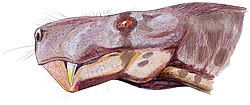Gorgonopsid
The Gorgonopsids [1] were Therapsids, a group of tetrapods which eventually gave rise to the cynodonts, with the cynodonts ultimately giving rise to mammals. Gorgonopsids probably had rhino like skin and still laid eggs.
| Gorgonopsia Temporal range: Middle to Late Permian
| |
|---|---|

| |
| Gorgonops | |
| Scientific classification | |
| Kingdom: | |
| Phylum: | |
| Class: | |
| Order: | |
| Suborder: | †Gorgonopsia Seeley, 1895
|
| Family: | †Gorgonopsidae Lydekker, 1890
|
| Subfamilies | |
|
Gorgonopsinae | |
Gorgonopsids were a successful group which lived during the Permian period, about 260 million years ago. They were members of the Class Synapsida and possibly related to the pelycosaurs. They became extinct in the Permian–Triassic extinction event.
They were the major predators of their day, having large, powerful, square-shaped jaws with huge, sabre-like canines and interlaced, socket-like teeth. Many fossils have been found in South Africa.
The most famous of all, Inostrancevia, was the size of Smilodon with a 45-cm long skull, and 12-cm long sabre-like teeth. The teeth were not as long as saber toothed cats but had a more robust skull. This predator could easily take down a Scutosaurus, or small animals such as Dvinosaurus.
The Gorgonopsidae are divided into three sub-families:
- Rubidginae, which had large, broad skulls,
- Gorgonopsinae, which included most of the gorgonopsid genera.
- Inostranceviinae
Notes
change